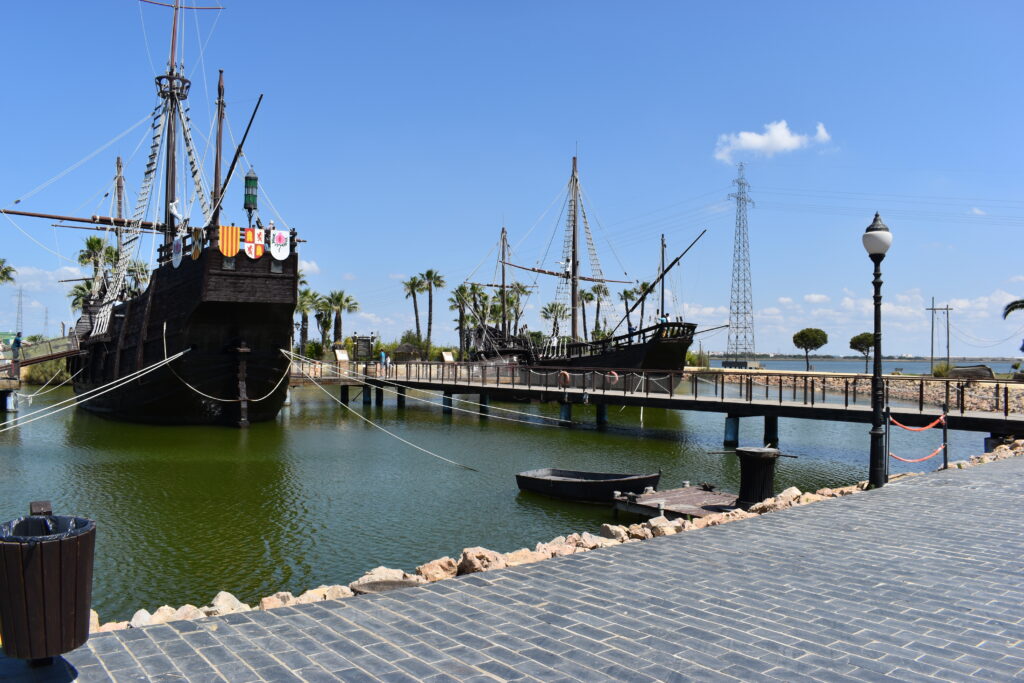This is the first entry in my Spain Field School blog. I’m heading out there in 2 days. Will be arriving a day ahead of everyone else as I am travelling independently. Guess I’d better think about packing soon….
May 15, 2023
Okay – so we’re up and running
Day One
Trip began by being dropped off by Mel on May 13 at Comox airport. Uneventful flight to Calgary – except some entitled mum had put her kid in my window seat and asked me if I wouldn’t mind sitting in the aisle. Getting the trip off to a good start I said sure fine, and then saw that the dad in seat across the aisle did exactly `the same to the lady there. Her kid played with his fancy iPad all trip and didn’t look out the window at all!
Then a big stroke of luck – all the domestic bays were full at Calgary airport so my flight arrived at international instead – which saved a long walk – dead opposite the lounge and about 100 metres from my departure gate. Jim one – airports nil. Good flight to London as had booked a seat with extra legroom, which also had a window and was pretty close to the toilets. Jim two – airports nil. Got into London on time – watched the sunrise and the sun set within 2 hours of each other but couldn’t grab any sleep as my body clock said it was still only midnight. Jim two airports one. Then the transfer for the connecting flight to Seville was closed so had to go through customs and immigration and then queue up again to get into departures again – two all. Snotty lady in the lounge at Gatwick sent me away because I was 20 minutes early to use my pass – two vs three. Priority boarded the Seville flight, had a good seat and arrived ahead of time. Three all draw for the trip – not bad at all.
Got a cab to the arranged meeting place in Seville about 8:45 local time– banged on the door – no answer. Found a side entrance and hollered – no answer. Rang the out of hours number – guy answers in Spanish speaks almost zero English and told me to go away and come back Monday at 9 when the office was open… Fortunately I could hear him through the walls so I rang the second out of hours line and got to meet up. He was a nice old boy really and wanted to help but the admin staff hadn’t told him to expect me on a Sunday evening. A girl turned up a little later and went through the same kind of experience. Fortunately she came from Brazil and spoke Portuguese and a little Spanish so between the three of us we got me round to the hall of residence just before 10pm.
Room turned out to be ‘full of character” about three feet between the two beds one small table that was the desk – but it had air conditioning – yay. Threw the bags down and ventured out into the night. Outdoor restaurant at the end of the road was buzzing. Had a nice selection of cheap Tapas I grabbed a couple of beers and, sardines and anchovies tapas and turned in for the night. Wasn’t sure whether I’d get to sleep as the body thought it was still 2 in the afternoon but had no trouble in the end.
Day Two
Woke about 5:30 – which was pretty good. Found the laptop was completely out of battery and the desk plug wouldn’t accept the adapter. Went back to the other residence for breakfast – looks like the low carb thing isn’t going to happen over here. Spanish breakfast is toast, cereal, jam Nutella and hot chocolate – the coffee was really good – but no decaf so that’s another adjustment to make. Hit the streets with a mission to find a bottle of shampoo – there was one sachet to last the week at the residence, another power adapter and if possible an extension cord so the laptop wouldn’t pull the adapter out of the wall. Also an iPhone lightening cable – turns out I brought three micro usb cords and only one lightning cord which was not USB compatible. Mission partially accomplished with lightning cable and power adapter but finding a regular shop that sold extension cords in a tourist centre was not working out. Had a good stroll around Seville including visiting the Parasols – which is a a weird architectural edifice built out of wood. Went up to the top to get the much-touted panoramic view of the city but had an attack of agoraphobia or vertigo and had to cling to the safety rail!! Strolled around the tourist centre and did some people watching at a couple of squares – which was fun
Some early observations from Seville:
- Mums and dads take their kids to school in the city centre holding hands – lovely
- Kids of three or four are sometimes still in strollers
- Waiters are not all young kids – often older men in aprons much the same as Italy
- Corner shops are generally run by Asian people rather than Indian people
- Far fewer people in shops and cafes speak English than I might have expected – Seville is a working Spanish city not just a tourist destination and I was not in the tourist cebtre much of the time
- When I was 18, I boldly walked on the sunny side of the street – 50 years later I creep along on the shady side – but so does everyone else in Seville
- I simply can’t take a nap or siesta – never have and likely never will – which is useful as I am back in my air conditioned room catching up at the moment
Brought my goodies back and ventured out for a second time in search of the elusive extension cord and also a computer mouse – which somehow, I managed to leave behind. Mission achieved and some more strolling around the city centre. Have not visited the cathedral and the museum of fine art which I passed several times, as they are both on the itinerary for class later.
Third mission – get batteries for the mouse – had the foresight to bring a couple of AA batteries just in case – new mouse takes two AAA.
So here we have it. I have found the cheapest tapas bar in Seville on my travels, just down the road, which has around 100+ tapas for 2-3 euros each, so that will be my destination a bit later. Hasta manana.

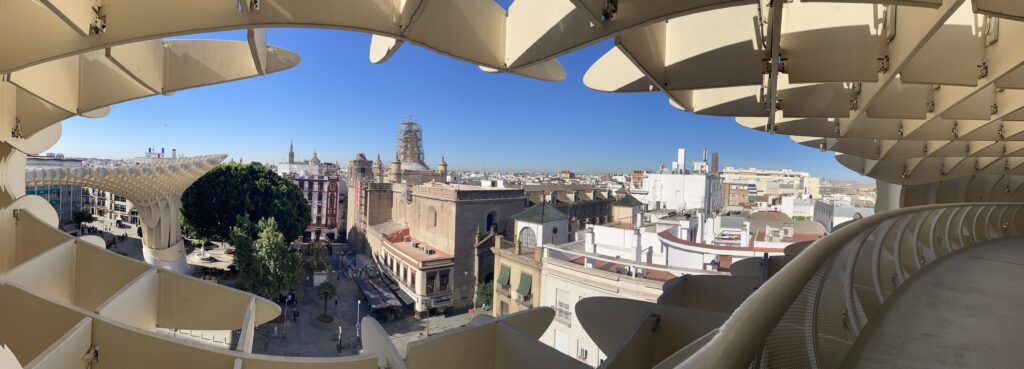
Day 3
Tapas were great last night – bottle of red wine and 5 different tapas for under 20 euros. Local soccer side were also playing so good atmosphere in the bar. Highlight was battered deep fried anchovies. Thank heavens I brought my laptop. I hadn’t realised quite how much work Sara, our art history instructor, had put up on the college website. Started downloading it yesterday but it was taking some time, so I thought I’d go to the local college to use their computers. Grabbed the usual bread roll ham and cheese at the digs and strolled down to the college – its about 20 minutes away by foot. Got there and caught up with Maria who I’d been exchanging emails with for a few days. She set me up on the computer so all systems go – or so I thought. Trouble was all the Microsoft Office software is in Spanish (obviously) so things like save and copy etc. instructions were in Spanish and also the keyboard layout is a bit different. Their IT guy came round to try to fix it and he managed to set up the keyboard but couldn’t change the office software – so I had to give up and go back to the digs for the laptop again.
When I was strolling around yesterday there were some North African lads who were selling fake Gucci bags and fake soccer shirts on the street. They were on white sheets on the sidewalk in the pedestrian areas. The local cops make regular slow drives along in that area and as soon as the cops turned the corner where the had a lookout posted they grabbed the sheets by the corners bundled everything up in the blink of an eye and scarpered down an alley.
The rest of the group from college were due to arrive about 5;30 this afternoon but it looks like they have had a delay and there might also be some lost luggage, so I hope to connect around 8:30 inshallah. I get to meet Brodie who’s going to be my roommate – never had one before!!

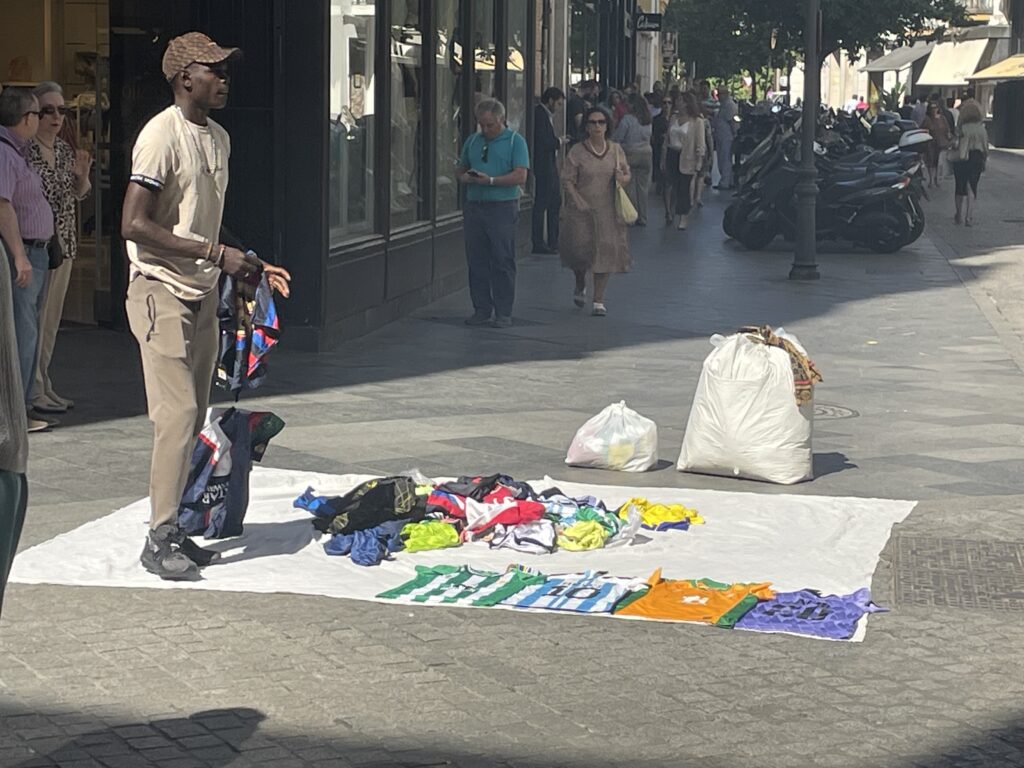
Day 4
My compadres had a rough time with their travel and In the end didn’t manage to arrive until abut 10:30 last night. Twisted a few arms and went out for a glass of wine with Carter (who is my roomie now not Brodie), Anne, Kathy, and Josephine at about 11;15. Stayed up chatting with Carter until later than was sensible – including some interesting chat about Don Quixote. Managed to forget to take my drugs this morning (possibly as a result of staying up later than was sensible!) so around lunchtime while we were walking around Seville Cathedral I felt pretty spaced out and I ultimately ended up bailing out a bit before the tour ended later this afternoon.
Had a great lunch with Alandis people – was only expecting a sandwich but we had a good meal at a local restaurant. In the afternoon we visited the Archives of the Indies – Sara our Alandis guide is super knowledgeable which was great. I have to confess that I am no great fan of touring cathedrals – this might not bode well for a three-week trip where we will be examining the meeting of the Christian Muslim and Jewish world in Andalucía…..but really enjoyed the Archives. Professor Dan asked us all to reflect on a few things each day so my take aways were:
- Magellan didn’t circumnavigate the world – his crew did, but he was killed in the Philippines
- Reminds me of Captain Cook also getting killed in the Pacific – some sort of poetic justice?
- How the mighty are fallen – Sic Transit Gloria Mundi – as my old Latin teacher would say
Sara our guide was keen to point out that the expeditions into the Americas by the Spanish were allegedly egalitarian affairs, with the Spanish treating the locals well – but I wonder if that might just be a teensy bit of poetic license and national pride, considering the doctrine of discovery of the 1500s.
Learned that a “dogma” is a principle officially authorised or recognised by the Vatican – brings a new meaning to dogmatic. Took some absolutely TERRIBLE photos – I’m going to blame being spaced out. Hope to find a sports bar that is showing the Man City vs Real Madrid Champion League semi final in a little while – If I don’t return alive back at the digs then I leave all my worldly goods to the dogs home – apart from any my family would like…

That’s the best of a really lousy bunch of photos – pay more attention tomorrow Jim
Day 5
Moving day. Set off early from Seville towards Trujillo. Trujillo in Extremadura, and several of the other towns in the region, was the home of many of the explorers who set off on their own journeys to the New World. In general these explorers were Caballeros or knights, but without much wealth or influence, and the voyages of discovery, while nominally about bringing Catholicism to the heathen savages, were also about the quest for wealth and adventure. You got to keep four fifths of any loot you managed to plunder with the rest going to the royal family (the quinto real). First stop was in Jerez de los Caballeros and the Vasco Núñez de Balboa Museum. If you google “Balboa” for a bit more information by the way, he isn’t Sylvester Stallone in Rocky, which comprises the top 100 search results. They can’t have done a great job of optimising the search engine (in-joke for the NIC digital crew).
He set off for the New World in 1500 and had a bit of an up and down time in Hispaniola (the island now known as Cuba and the Dominican Republic), with a couple of failed ventures, and had to leg it to the mainland by stowing away to escape his creditors. Balboa worked his way up a motley crew of other adventurers, including Pizarro (more to follow about him later today) to become governor of one of the new mainland settlements. One of his achievements was crossing the Isthmus of Panama becoming one of the first Europeans to see the Pacific Ocean. As ever there was constant infighting among the brigands and explorers with mutual accusations and plots, and Balboa was eventually executed after another one of the other conquistadors set him up. Note the prosaic language in this paragraph. We have been tasked with looking at events under different cultural lenses and I am looking at the conquistadors expeditions with a jaundiced western eye rather than a romantic Spanish one for the purpose of this entry.
From Jerez we set off for Trujillo. Sadly Sara, our guide, took a bad fall disembarking the coach and injured her ankle badly. From not only a compassionate perspective but also one of self interest I hope she recovers quickly as she has been wonderful so far. The hotel here is a bit of a step up from the digs in Seville! The excitement in Trujillo was that they were shooting part of the sequel to Game of Thrones in the town square – it is an authentic medieval setting. A few of us tried to get a sneak peep past the security and managed to grab a couple of surreptitious shots of the extras as they were heading back down from the filming.
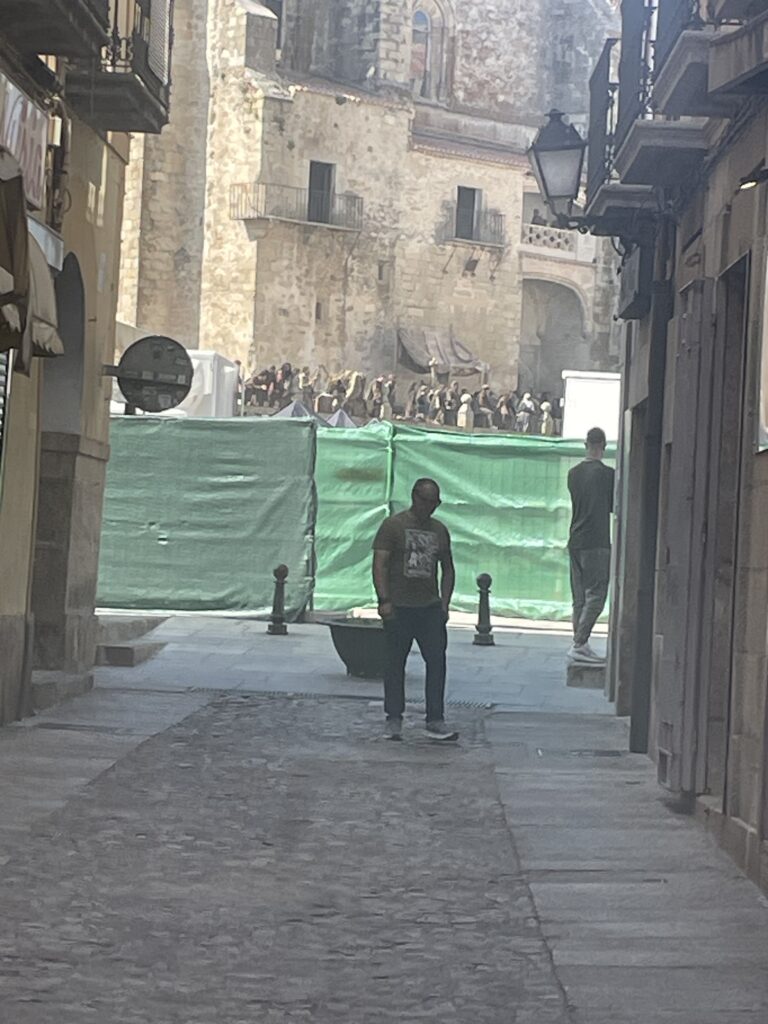

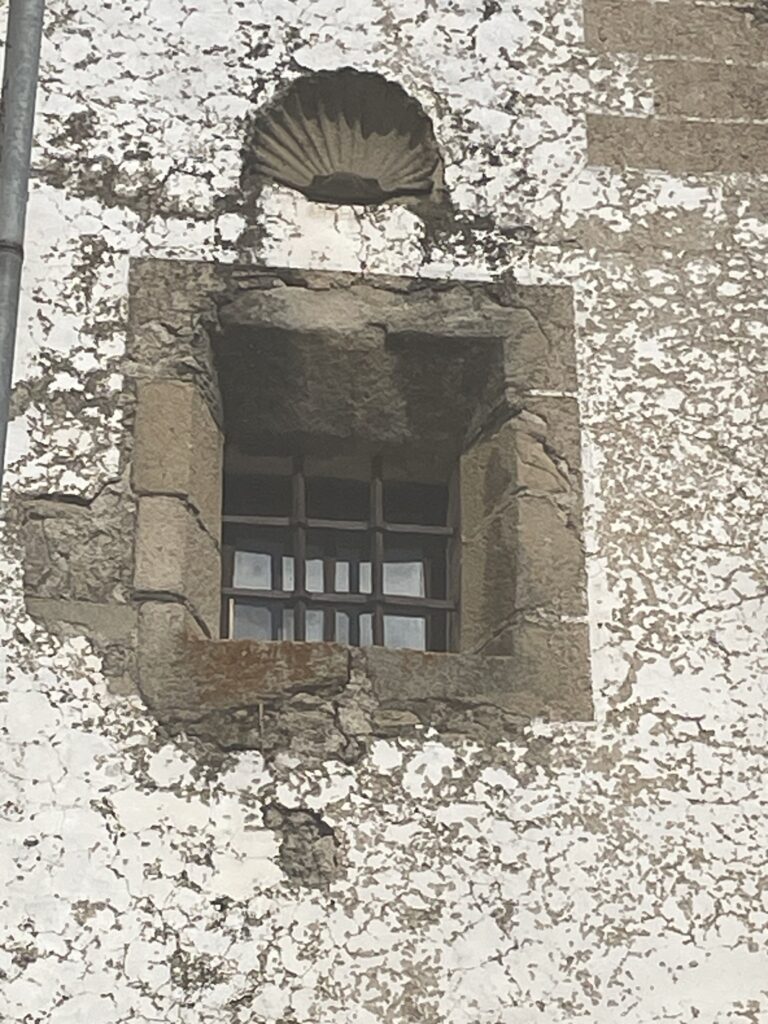

Unlike Balboa, who was born to a reasonably wealthy family, Francisco Pizarro was reportedly born to a poor family in Trujillo. (Though having just visited the museum housed in what was apparently was his former house it doesn’t look like it was abject poverty) He sailed for the new world in 1509, nine years after Balboa, by which time Spanish colonies were becoming better established in Central America and working their way into South America. After several unsuccessful campaigns Pizarro finally “conquered” Peru in 1532/1533. He captured the Inca leader Atahualpa and demanded a ransom of a room full of gold and two rooms full of silver. He was ordered to execute Atahualpa for a number of crimes, but was reportedly reluctant to so. Its likely that the execution was more like a settling of old scores as the charges were a bit dubious. The relationship between Pizzaro and Atahualpa is dramatized in Peter Schaeffer’s wonderful play The Royal Hunt of the Sun. So here’s today’s connection: I saw the Royal Hunt of the Sun at the Well Hall Odeon Cinema in South London on my first serious date with one particular girl in 1972.
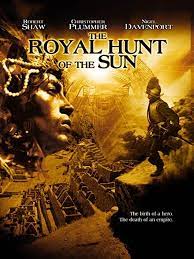
Today is a free day wandering the cobbled streets of Trujillo’s medieval town. We were introduced to the medium format camera the Holga. We have a sixteen shot roll of black and white film to have some fun with. Oooh the anticipation. When I was first shooting analog sixty years ago you never knew what you had taken until you had sent the film off to be developed. Would every picture feature your thumb? Would one in three be worth sticking in the family album? We’ll have to wait and see – because the films won’t be developed until we get back to Seville. Watch this space! (I’m sure you all will watch this space as the blog is so edifying that everyone is glued to it 🙂
DAY 6

Holy Jamoley – quite literally. Today’s trip was to the monastery in Guadeloupe (see above). My idea of a monastery is a humble place where a few guys in coarse brown robes wander around the cloisters thinking about god. The monks would be kind hearted souls who denounced a life of wealth, grew herbs in the garden, perhaps kept bees, looked after the sick – you get the idea – and feel quite good about the whole process.
The monastery in Guadeloupe is massive. It has been a site of pilgrimage for hundreds of years as it is associated with the cult of the Black Madonna. The exterior is massive – the interior is opulent – perhaps rivalling what we saw in Seville cathedral. Tonight I’m looking through the Marxist lens – which is not too difficult as I am a socialist myself. I think about where all the money came from to build and furnish this monstrosity and the fearmongering of the catholic church which held the population in sway with the threat of eternal damnation for decades until the reformation. Even the aristocracy were in on the scam and chipped in loads of cash – but their cash came at the expense of the poor souls who toiled for them in fiefdom under the feudal system.
The discussion as we walked round the old town included the origins of the Cult of Mary and how she was soon incorporated into the early Christians’ cannon after the death of Jesús (who I think was probably a pretty nice chap like the humble monks). We see her early on in the worship of Venus Aphrodite – who had similar attributes – so in the way that so many religions develop, we don’t want to completely discard the old gods we worshipped just in case, so we incorporate them in our new religion and hedge our bets a bit just in case we’re wrong…
Enough reflection for tonight. Todays photos were a bit better than a couple of days ago I hope, and my favorite today is this one – of one of our fellow students Josephine, chatting with Professor Dan in the cloisters of the Monastery.

DAY 7
I’m starting this on the bus dropping in on the chit chat all around ,with a few people also catching up with a nap. Merida was a stop which was a bit out of the syllabus. It was a no brainer however to stop as its an important site and we were passing it on our return trip from Trujillo to Seville. It is home to the best preserved/reconstructed Roman theatre in the world according to our guide, Juan, who took us around at a frantic pace but with great humor. All our guides so far have shown a great pride in their own turf – perhaps a Spanish trait? And of course when we are toured around that’s the cultural lens through which the sites are explained. In this case I reckon he is on pretty solid ground having fact checked him a bit on Wikipedia.
The Roman period is the one I enjoy the most in history and also one which I have picked up a bit more knowledge about – which almost then becomes a self-fulfilling prophecy in terms of learning. My Latin teacher Stan Wolfson introduced me to Rome and its history in 1966 when I was 11, and for some reason it really clicked with me. I was never a great student at that time but I can hear his voice still in my head more than 50 years later. I still correspond with him.
Medina traces its roots back to the time of Emperor Augustus, and the theatre and amphitheater were established by Agrippa his key consul. The early Roman emperors and their dynastic infighting were so well portrayed in Robert Graves novels I Claudius and Claudius the God, and I’m sure that those books also are part of the lens through which I see the Roman period
I’m glad that the trip to Medina is not available as a source for our final project, as I would be tempted to fall back on old habits and work on that – which actually enabled me to go along with the ride, not take dozens of photos and pay more attention to the guide instead
High points from Medina?
Guide Juan’s quirky presentation style.
The stunning reconstruction which I am pretty sure must be fairly authentic of the theatre facade from a kit of fallen spare parts which were excavated from 8 metres underground.
Remembering that Amphitheatre’s roots come from “two theatres” due to its oval shape including two semi circles – same prefix root for two or both in Latin (though “ambi” or “ampi” I think derived from Greek) as Ambidextrous – having two right hands .
Another example of the cult of Mary was shown in a photo on a curators display at the museum.which I believe is Isis nursing Horus – that Madonna sure is ubiquitous….
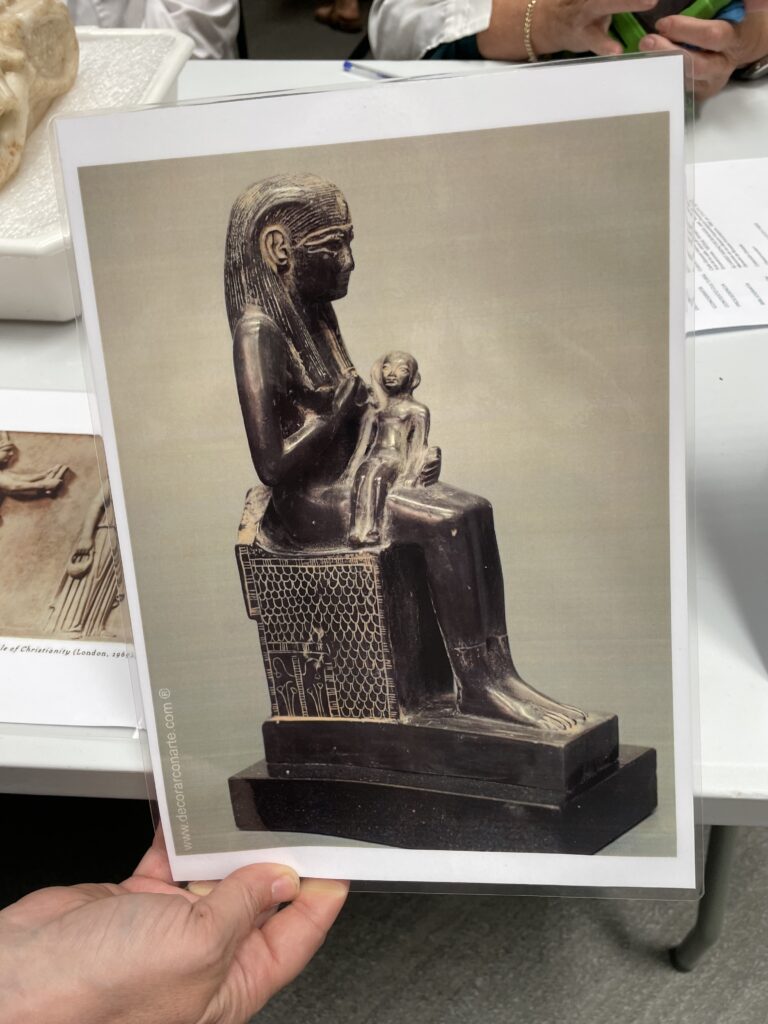
Ooooh yeas and before I forget on the subject of the Madonna: When Dan was chatting with our guide yesterday he mentioned the symbolism of the shells in some of the places in the old town in Guadeloupe. The guide explained the shells were a symbol of pilgrimage (which we sort of already knew). But Dan pressed him a little further about the particular type of shell and the guide wasn’t too certain about that. But guess which shell it is – the scallop shell – and guess who also is depicted in a scallop shell? –

DAY 8
Today we visited the Seville Alcazar, the royal palace, al-qaṣr in arabic likely derived from the Latin castrum. Another fantastic guide, this time Enrico. Obviously though very few major historic buildings can be regarded as being wholly secular, the Alcazar was primarily a residence rather than a place of worship. I’m not planning here to regurgitate what the guide said and can be found on WikiPedia so this is Alcazar through my eyes.
It was interesting to see the juxtaposition of Arabic design and western Christian purpose in one building. Lots of Islamic ornamentation with the just the odd flash of Castille with the lions and the castle hiding among the swirls and diamonds. The gardens were stunning. I’ll let the pictures speak for themselves. It was interesting to see orange trees espaliered to cling to and cover the walls. Apparently there are around 50 varieties of oranges and you can tell the bitter ones like Seville oranges because thy have a double leaf structure with a small leaf near the stem.

We left the Alcazar and strolled through the narrow winding streets of the Jewish quarter. One of the questions which I had the inkling of an answer to that was clarified on the tour for me was why Jews have been persecuted by so many different societies. While usury is technically interdicted both for Christians and Muslims, the powerful of the world constantly need to borrow money, generally to fight wars, and someone needs to lend it to them, and the Jewish religion doesn’t preclude lending money for interest. That’s why the Jews of Seville remained protected by the Royal family for so long, but other people who had perhaps defaulted on their loans and lost their land or resented paying interest took the opportunity to exact some sort of revenge. Surprisingly given the situation in the Middle East now, the Muslims in Andalusia had been relatively tolerant of the Jewish community compared with the Roman Catholic and in the interregnum after the death of Peter 1 who had protected the Jews in Seville at the urging of the Catholic bishops 90 percent were massacred by the local population.
Here are a few photos of the Alcazar – which of course do not even come close to doing it justice. The star is the first piece of Jewish iconography that I have seen in Spain so far in the gateway leaving the palace into the gardens

A few general images of the gardens – I’m sure many other students have much better photos inside the palace so I will defer to those images

These are the orange trees espaliered to the walls

Wikipedia informs me that the date palm is not native to Spain. Legend has it that Ab Del Rahmen introduced them as he was pining for his homeland.
Finally Enrico told us than the artisans who put the ceramic mosaics on the wall included a little signature piece which identified their handiwork, and showed where their work started. It was a sort of invoice to show how much of the painstaking work they had actually done so they got paid properly. Can you see the special little tile?

I couldn’t make a post without a quick mention of our Mary. The last stop on the tour was an absolutely sumptuous Baroque church and here she is on the altarpiece. Having been brought up atheist, but coming from a country where the Church of England was the main cult following the schism in the wake of Henry VIII’s desire to divorce Catherine of Aragon (which probably was not at all popular in Spain as well as Rome) on the altar you would always see Jesus, but Enrico told us that Mary is so important in Spain because in Spain they love their mothers above everyone else – happy mothers day last week to all the mums out there…
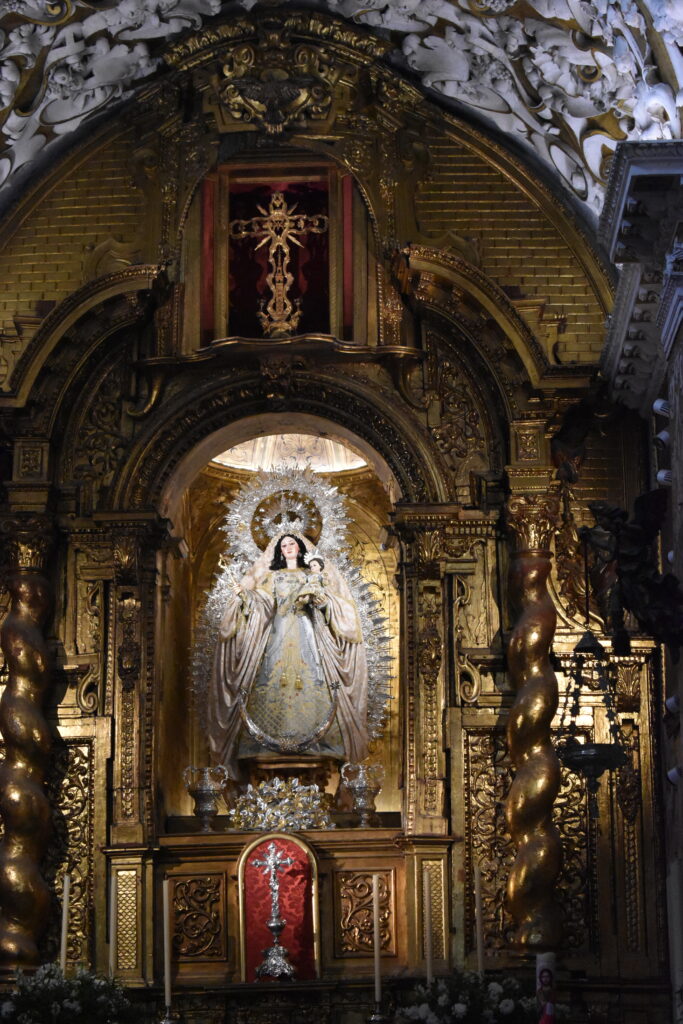
DAY 9
When listening to Enrique our guide talking about the history of the Barrio de Triana, there was much to absorb, but generally speaking when an interesting snippet comes up that I want to reflect on later I send myself a brief text. Today I sent myself two texts. The first says “1935 Spain took property from the church as it was getting too powerful”. The second says “Gypsies flamenco sad”. So these will be the topics of my blog for today, even though the first one falls outside way outside our time period of 711-1492.
We have seen through our site visits that the Catholic Church has been one of the most powerful forces in Spanish History. At the time of inquisition, the inquisitors were ruled directly from Rome and seized and tortured people from all walks of life that were critical of the Catholic dogma. Across the continent including Spain the Royal families in many countries were powerless to intervene against the actions of the inquisition. My assumption was that the Catholic church would still have a powerful voice in present day Spanish politics. Our guide Enrique, who is a catholic himself, claimed that more than 80% of Spaniards are Catholic, particularly in southern Spain. A quick fact check suggests however that that figure was 70% in 2011 and had fallen to 57% by January 2022.
At the time of the second Spanish republic in 1931 the constitution introduced female suffrage, civil marriage and divorce. It also established free, obligatory, secular education for all. However, some laws nationalized Roman Catholic Church properties and required the Roman Catholic Church to pay rent for the use of properties which it had previously owned. In addition, the government forbade public manifestations of Catholicism such as processions on religious feast days, dissolved the Jesuits and banned Catholic education by prohibiting the religious communities of nuns, priests and brothers from teaching even in private schools. This was overturned by Franco when he came into power, but Spain’s constitution states that no religion has an official status.
The second text concerns the origins of flamenco music, which it is claimed are rooted in the Triana enclave in Seville. Apparently gypsies wandered from Egypt across North Africa to Morocco and from there to southern Spain, bringing their own musical styles with them. Here in Andalusia they heard the call and response style of chanting from the Islamic call to prayer from the towers of the mosques and incorporated this rather sad sounding vocalisation into the very earlies forms of flamenco. Through time it has progressed however and now incorporates a wide range of styles, adding dancing to thye singing and music.
Today’s photos are from the Triana Market.
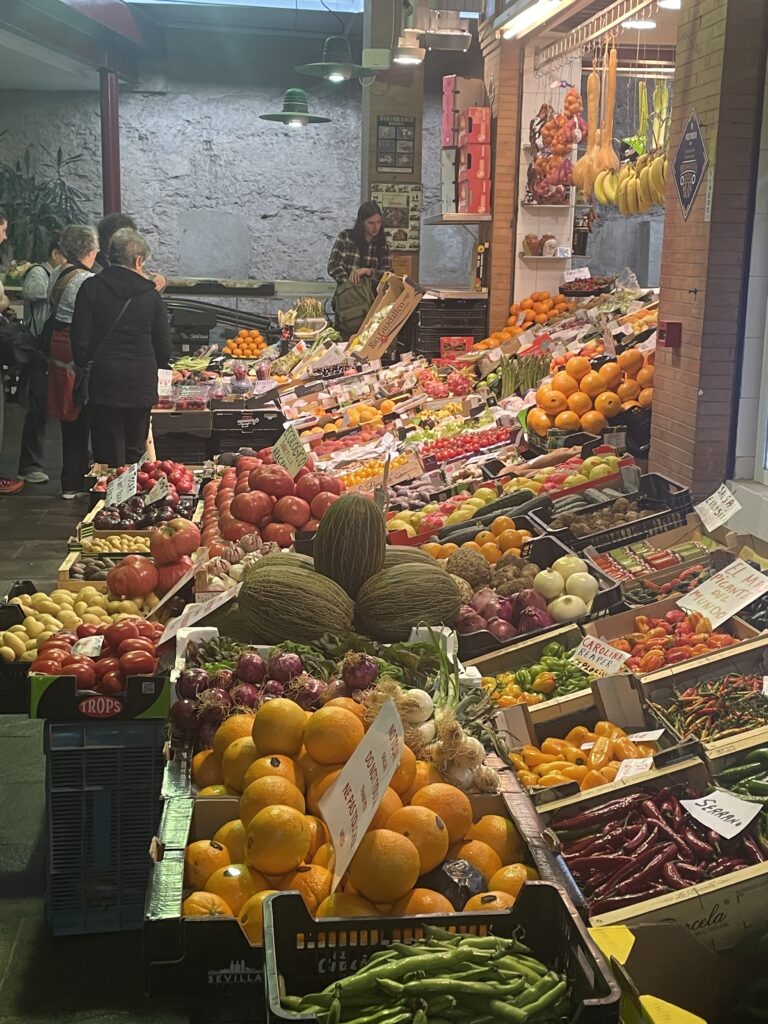
and of course Mary – this time with her mum….

DAY 10
Today the people in our group on this field trip were privileged to almost certainly be some of the last non-archaeologist individuals to see original cave art, not only at the Cueva de la Pileta in Spain, where we were, but in any site across Europe. This type of art, also known as parietal art, is so sensitive to atmospheric conditions that all the other major parietal sites in Europe such as Lascaux and Altamira, now only allow access to archaeologists, and even then on a very limited basis. The Cueva de la Pileta remains in the hands of the farmers on whose lands they are located and who now put themselves forward as the custodians of the site, despite ongoing efforts from local authorities to take it over.
Under the management of the family the site is currently visited by 30-40 people each day under strict conditions, such as no photographs, even on phones and without flash. Nonetheless the conservation purists will likely argue even that is too much, and I am sure that view will eventually prevail. I have to agree with the purists (but then again, I am one of the lucky few, which makes life a bit easier to support this position n’est-ce pas). Interestingly the “no photograph” rule is to not only to protect the paintings but also to protect the thousands of bats from 40 different species, who are disturbed by the emissions from phones and cameras.
To experience the conditions under which the art was created gives a perspective on how determined our ancestors, 40,000 years ago, were to place these images up on the walls. Now the route has carved steps and handrails but at that time the first homo sapiens sapiens, in the Paleolithic era, would have had to clamber and crawl their way across slippery rock, hundreds of metres into the ground, to paint images of aurochs, deer and amazingly a giant fish which looks convincingly like a halibut. Other images included many straight line symbols which have been interpreted as likely being moon cycle tallies, but again, this can only be supposition
What was it that drove them to go to such extreme lengths and create the designs with only an oil lamp made out of a shell and fuelled by animal fat or marrow bone to light the way? Archaeologists have postulated many explanations, but the truth is we will never know for sure. I can’t imagine how any of our next visits could exceed this experience for the remainder of this field school – but hey – let’s keep an open mind – we may find the Arc of the Covenant hidden in one of the many Knight Templar sites in Almeria?.
In contrast, our second site visit in Ronda was to the Bullring Museum. According to the audio guide, there were even objections, on the grounds of animal cruelty, to hold these debacles 450 years ago, when the arena was built. I wanted to give the visit a chance, but by the time we got to the description of how the bull is sacrificed for entertainment, I had to drop out of the tour. Our guide on the way home on the bus wanted to give her personal opinion about the bullfight, and why it had positive aspects, and in the context of this whole field school of looking at everything through other peoples’ eyes (cultural lens), I was fine with doing so, but it had absolutely no impact on how I personally view bullfighting.

Our group on this field trip were privileged to almost certainly be some of the last non-archaeologist individuals to see original cave art, not only at the Cueva de la Pileta in Spain, where we were, but in any site across Europe. This type of art, also known as parietal art, is so sensitive to atmospheric conditions that all the other major parietal sites in Europe such as Lascaux and Altamira, now only allow access to archaeologists, and even then, on a very limited basis
This is the “Big Fish”. The Cueva is about 70km from the sea, and while many images are of animals, there are apparently a dozen or so images of fish, and all of them are painted on a grand scale. The fish image’s are all one meter across, whereas many of the animals are only 250 cm or less. Our guide wondered whether this was the origins of fishermen boasting about the size oi their catch?

These are some of the more abstract and symbolic images in the cave. No originals from me I’m afraid….
DAY 11
So…. Today was a day off with no specific plans – except for a photo critique around 5PM. I had looked up flea markets before leaving Canada, and our free day coincided with the main flea market day in Seville. I’ve been badly missing cruising the junk and antique shops around Courtenay / Comox and the auctions in Victoria as so many have shut down in the last 3 years, so a dose of bargain hunting was very exciting.
It was a pretty good market, though it had more than its fair share of gee-gaws and trinkets, and with a decent sprinkling of fakes, and high prices to boot. Ended up with buying 4 items for a total cost of $13:50 – see picture.

The best was a hand made artifact described as an “espumader” – a sort of scoop or strainer. Its clearly hand made out of steel and my guess would put it at least 80 years old. Then a rubber ink stamp for a pharmaceutical manufacturer in Lisbon, one tile, and a small magnifying glass.
The magnifying glass is brand new and cheap, but I had actually been looking for one to use in my images, as an emblem of the lens through which other things are looked through on the trip. This one is tangible and makes things look bigger when you look through it, rather than the cultural lens, the theme of our field trip, which is no less real in some ways, but is a combination of a lens and a mirror.
The photo critique was fun. As usual with NIC fine art school critiques, everyone found something to like (and sometimes “love”) in almost all the photos, most of which the creator I don’t think had ever consciously intended. I felt my three were OK but not particularly good. I would say three or four photos were really good, and the rest were pretty mediocre – but what do I know? – perhaps we are travelling in a group of photographic geniuses? This blog is totally accessible to all my fellow travelers – but rest assured if you are reading this all your pictures are on the brilliant list not the mediocre list.
So a short entry tonight. We hit the road for seven days tomorrow to Cordoba and Granada. Ole.
Day 12
What a contrast between two Cathedrals. We arrived in Granada today after a three hour coach ride from Seville. The hotel is also in sharp contrast with the student digs in Seville. It has a couple of pools, a spa and is altogether a great place to stay. Not quite as close to downtown as in Seville, but taxis are super cheap, so no big deal at all. After a bit of free time, we met our guide Richard at the Royal Chapel. I’m not sure where the tour company finds these guides, but Richard was also a real piece of work. With a sardonic teasing approach, I wasn’t sure whether he was English or Spanish – he had a strong British accent, but his name looked to be Spanish???
The Royal Chapel was the place where Ferdinand and Isabella, the king and queen at the time of the re-conquest of Granada in 1492, chose to be buried. This was a political move, as both monarchs came from different Spanish royal houses. Ferdinand was from Aragon, and Isabella from Castille, so they chose neutral ground in Andalusia to be the resting place of the Catholic monarchs thereafter. Their grandson, Charles 5, had different ideas – but that’s another story. Hey and guess what? The star of the show on the main altarpiece was Jesus! An absolute shocker after all the Mary’s we’ve seen in the last 10 days.
From the Chapel it was a short step round the corner to the Cathedral. The contrast between Granada Cathedral and Seville Cathedral is stunning. My plan here was to show a photo of the interior of each, but I realise that the photos I took in Seville cathedral were so dark gloomy and depressing that I deleted all of them! Probably not a smart move in terms of keeping a record of the trip but I absolutely hated the place. Seville is full of little side chapels with iron grilles, the choir in the middle of the main isle (the seating area for the clergy and big wigs) obscures siight of the main altar – the hoi poloi would be seated behind the choir and would then have to go round the choir to even get site of the altar.
Granada cathedral has two tiers of windows above the capitals of the columns that support the ceiling and there is stained glass above the chancel, which makes the whole area so much more spacious. The choir was demolished a couple of times due to earthquakes, which are common in the region, and was eventually rebuilt behind the chancel, which gives an amazing unobstructed view down the main nave, which is unique in European cathedrals. The main columns are painted white, adding to the airiness of the building. I found Mary lurking in a couple of side chapels by the way.
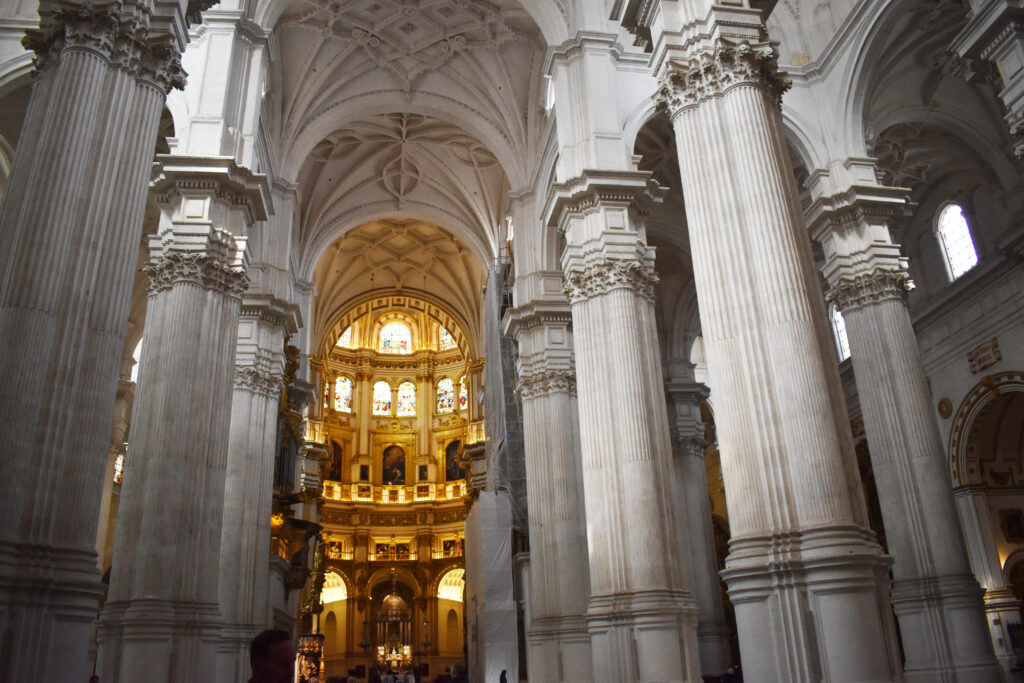
there was no flash allowed in the cathedral so I’ve had to cheat a bit with photoshop but what you see is about what your get
DAY 13
It’s hard to believe that we are more than half way through the field school now. Today we were literally Standing in Rusafa, where Abd-al Rahmen wrote his poem pining for his Syrian homeland
“A palm tree stands in the middle of Rusafa,
Born in the West, far from the land of palms.
I said to it: How like me you are, far away and in exile,
In long separation from family and friends.
You have sprung from soil in which you are a stranger,
And I, like you, am far from home”
DAY 14
Today is a rest day and an opportunity to recharge the batteries. After the visit to the Alhambra yesterday there was an evening walk in the old town of Granada. As ever, absolutely fascinating and great views of the Alhambra from high up in the city, but we had just started our decent down the cobbled streets when the heavens opened. A serious deluge with thunder and lightening to boot. Within minutes there were little rivulets running down the cobbles. I was soaked through in minutes and it was so wet I feared for my wallet and phone in my shorts pockets and my roomie Carter kindly kept them in his bag for me. Several of the group headed out for a flamenco show later that evening, but I had a shower and then dried out my saturated shorts with a hair dryer as they were the only ones I had to wear. Its great having so much activity crammed into a day, but it was good to have some down time today.
Another fun thing on a busy day, and 6000 kilometers, away my cricket team were playing their first home game of the season, and due to the marvels of technology I was able to follow a ball by ball account on the internet. I had to give up at midnight to get some sleep, but yesterday was also the day when Granada Football Club won their last match of the season and will be promoted to top tier Spanish Football. This will be huge for the club and its supporters in terms of both prestige and money for the city. Car horns were sounding and fireworks going off until the wee hours. Our lads also won their match in Campbell River, but by then it was 3am and that I found out this morning.
So what did I do with all this lovely time? School work! I’m pretty diligent in keeping up and make sure that at least my blog is completed every day and assignment deadlines are met – but I have had to work hard to do that. I’m a pretty fast writer and, without tooting my horn too much, pretty well educated and articulate, but the sheer volume of work on the field school, I think, may be too much for many of my fellow travellers to complete to the best of their abilities. I’m not sure if this blog will be read in full at the end of the final project but hopefully the instructors will bear that in mind for the future.
One of today’s homework tasks was to interview some Spanish people and get their opinions on a number of issues, some straightforward others more complex. I took the easy option and chose to interview our tour guide as she is fluent in English, and also had a brief chat with one of the waitresses in a pizza bar who spoke pretty good English. I wont rehash the whole process here, but suffice to say that some of the post colonial values that we are conscious of in Canada haven’t percolated their way through Spanish society yet, and the Catholic church still has huge influence in what is constitutionally a secular country…..
On to the great Mosque in Cordova tomorrow. I hadn’t realised before the trip it but around the 10th and 11th centuries Cordova was the cultural capital of the world with a melting pot of Muslim, Christian and Jewish influences. Bring it on….
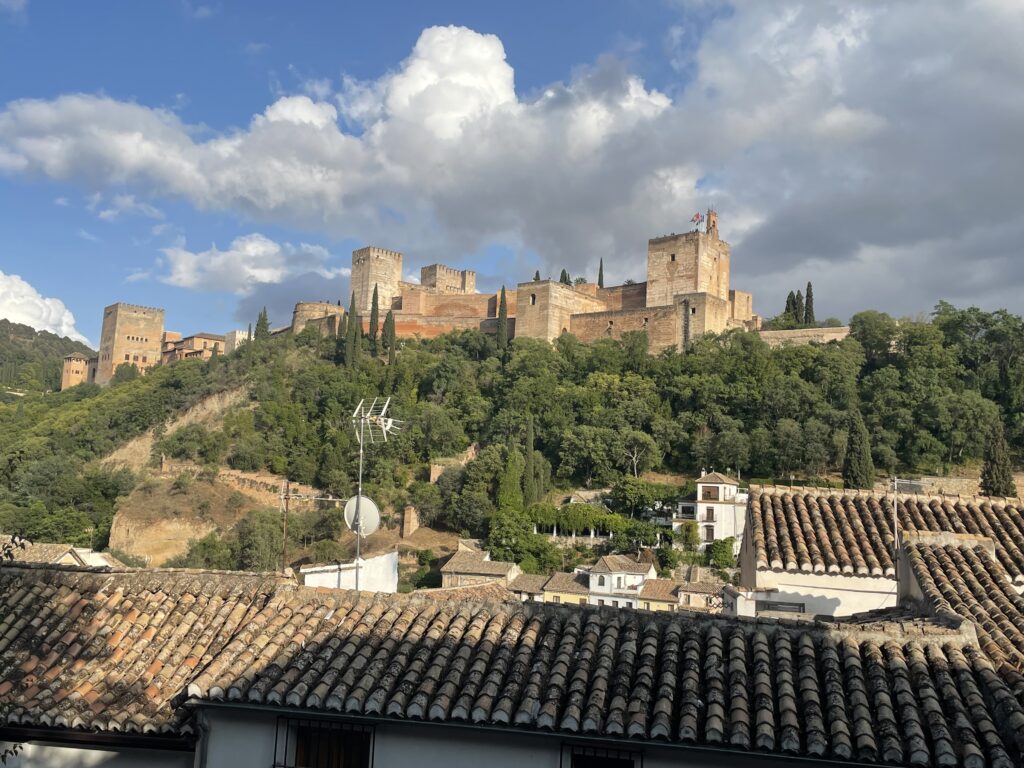
DAY 15
I had thought that the Alhambra in Granada would be a hard act to follow, but Andalucía had something else hiding up its’ sleeve, or perhaps not hiding if I had done my homework properly – sorry Professor Dan. The Cordoba Mosque is???? – help me here I’m running out of adjectives for amazing buildings. So, let’s start with a little bit of history to meet the requirements of the blog before we get into the personal stuff.
Our adventurer Abd al-Rahman fled from his home in Syria after his whole family was wiped out in an internecine war with another Muslim faction and arrived in Spain in 755 CE. As beautifully expressed in the poem Standing in Rusafa (turn back a couple of pages), he pined for his home country, always hoping to return, but shortly before his death he realised that this would never happen, so he ordered the construction of a Mosque in Cordoba.
Like all building projects (and bear me out here my lovely family, Mel, Giles, and Fergus, who have lived with me in building sites for 40 years now) they always take a bit longer than you expected and cost a bit more than you hoped. It was started in 785 and the first phase was completed very quickly in 786, just before al-Raman died in 788. It was built so quickly because the builders re-used columns and other materials from the earlier Christian church on the site and other buildings in the area. The columns supporting the main structure have a deflection plane made of lead between the column and the base and the column and the capital, to help protect against earthquakes endemic to the region. But that was just the beginning, and the mosque went through multiple additions under the Muslim rulers in the end, creating a most magnificent structure, which on its day would have 15,000 people praying together, filling the vast mosque and spilling over into the courtyard outside. This mosque is the second largest mosque in the world after only the Great Mosque in Mecca. Then……along came the horrible Catholic Christians in 1236 (Boo Boo).
Here’s where it gets personal. These psychopathic vandals after overrunning the Muslims in Cordoba in 1236, needed to stamp their exclusionary faith on everyone, even though Muslims Christians and Jews who had lived reasonably harmoniously in Cordoba for 500 years. They started small by building a small church in one corner of the mosque, but then under the auspices of Charles 1, built a whopping great cathedral right in the middle of the mosque.
Photos of the mosque will follow. I also took some of the Christian Church because, I have to admit, that it’s a great structure and worthy of recording, but photos on this page will be limited to the Muslim aspects of the mosque.
While doing a bit of research today I came across this poem, which I feel ties in beautifully with our theme of the meeting of cultures. It was written in Cordoba, where Christians, Jews and Muslims had been living harmoniously for 500 years.
Muhyyeddin Ibn Arabi (1165-1240 CE)
“My heart has become capable of every form: it is a pasture for gazelles and a convent for
Christian monks,and a temple for idols, and the pilgrim’s Ka’ba, and the tables of the Tora and the
book of the Koran.
I follow the religion of Love, whichever way his camels take. My religion and my
faith is the true religion.
We have a pattern in Bishr, the lover of Hind and her sister, and in Qays and Lubna,
and in Mayya and Ghaylan”
DAY 16
Still in Cordoba and Terry, a Brit from Liverpool with a dry sense of humor who showed us round the Mosque, was our guide again today at the Medina Azahara complex. Despite having some pretty nice digs in downtown Cordoba, Abd ar-Rahman III, the Caliph, decided in 940 CE he .would like a palace out in the country. The legend has it that it was built for his wife who was homesick for the mountains of Syria so he planted almond trees on the steep hill behind, so the white blossoms would remind her of the snowy mountains. More likely he had just founded the Caliphate so he was out to build a palace rich enough to impress the foreign ambassadors anxious to do trade with him.
It took 35 years to build, but was scarcely occupied, as the usurper Al-Mansur decided to move back downtown and in 981 and the whole complex was burned to the ground around 1012 with the stones and all the other sumptuous building materials being plundered by the locals. As usual one of the chief plunderers was the church – who took much of the material to build a new monastery. The transient nature of the castle puts me in mind of Shelley’s poem Ozymandias
I met a traveller from an antique land,
Who said—“Two vast and trunkless legs of stone
Stand in the desert. . . . Near them, on the sand,
Half sunk a shattered visage lies, whose frown,
And wrinkled lip, and sneer of cold command,
Tell that its sculptor well those passions read
Which yet survive, stamped on these lifeless things,
The hand that mocked them, and the heart that fed;
And on the pedestal, these words appear:
My name is Ozymandias, King of Kings;
Look on my Works, ye Mighty, and despair!
Nothing beside remains. Round the decay
Of that colossal Wreck, boundless and bare
The lone and level sands stretch far away.”

an update on the definition of fallen arches….

and finally today we scanned the negatives from our Holga cameras today and this is my favorite image

DAY 17
Our last day in Cordoba. It will be quite the culture shock returning to the student rooms in Seville after six days on the road in nice hotels. This last place has the best breakfast buffet I have ever seen – apart from the Hilton in London. Todays visits comprised the Cordoba Jewish Quarter and the Cordoba Alcazar. Of the three major religions there are very few Jewish buildings we have visited in Spain. If I heard the guide correctly – and its a bit of a blur now there are still only 3 working synagogues in Spain and the Jewish people in Cordoba have to catch the train to Seville and back every Saturday to pray.. The synagogues in Cordoba is very small 7x7x7 meters. It can accommodate 40 tourists at a time and you get exactly 4 minutes to look around before the next group is ushered in and you are ushered out (at least according to our guide terry yesterday though it seemed a bit longer). Todays fabulous guide was Angel. Not too much to report about the synagogue. As ever the Christians took over the building when the Jews were expelled from Spain, but is restored to its fairly austere state now. men and women were segregated for prayers, men downstairs women upstairs.
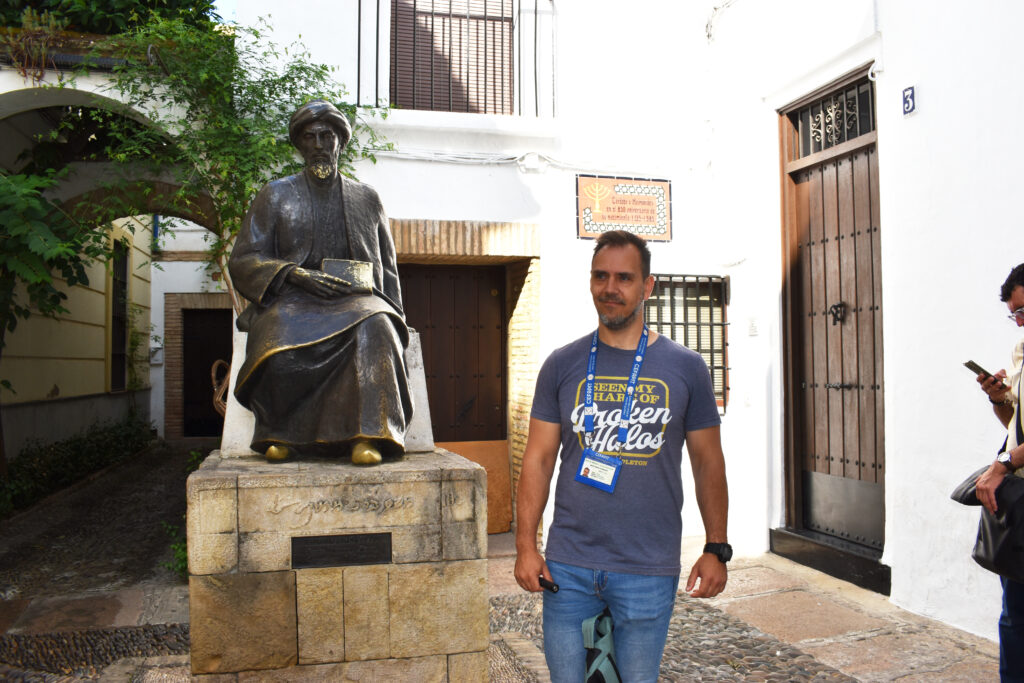
Here is Angel, with Maimonides in the background. Apparently he was one of the greatest Jewish Scholars and wrote the definitive books on Judaism in the 12th century. He was a polymath with expertise in medicine, philosophy, astronomy etc. You name it – he knew it – 12th Century Google. As you can see people touch his shoes, book, and beard hoping that his wisdom will rub off, but I fear the only thing that rubs of is the patina on the bronze statue.
Also visited the Cordoba Alcazar – I’m running out of steam for royal palaces I’m afraid but our guide was brilliant and he managed to relate the whole history of Spain from before Christ to the present in 11 Minutes. Gardens were very pretty – reminded me of Versailles as the Spanish Royal family married into the Bourbon family and French Royalty..
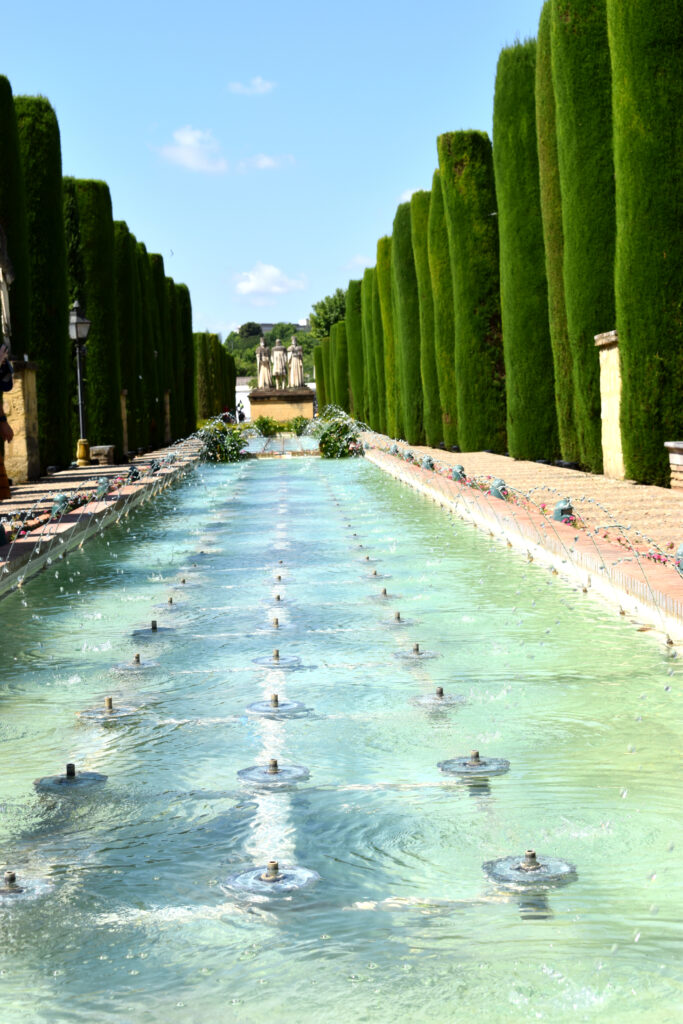
DAY 18
So far on this trip around Al Andalus, there have been relatively few opportunities to reflect on the indigenous component of the meeting of four cultures. We had some early exposure to the voyages of Balboa and other conquistadores, but of course only from the perspective of the coloniser. Today we visited then house in Montilla of Inca Garcilaso de la Vega. His father was the Spanish captain and conquistador, Sebastián Garcilaso de la Vega, who arrived in Peru around the time of the hostage taking of Atahualpa. He met, fell in love with, and married an indigenous princess, Palla Chimpu Ocllo. Their son was a mestizo, or person of mixed blood, and as such despite, (or more accurately because of), the pedigree of both his father and mother, he was mistrusted by both the settlers and the indigenous people. He grew up fluent in both indigenous and settler languages and cultures. When his father died and he inherited some of his wealth he was “encouraged” to return to Spain to his family in Andalusia, but his wealthy relations did not welcome him back, due to his mixed race. His uncle became his patron in Montilla, and he wrote extensively on the Inca culture, though his works were banned in Spain and its colonies for many years, due to fears of painting a more positive picture of the indigenous people, which Spain had represented as bloodthirsty savages, and encouraging potential uprisings.
That was a bit of dry history wasn’t it? I’m trying hard to include aspects of all 4 cultures, but the Jewish and Indigenous tend to be subsumed by the Muslim and the Catholic. As a little light relief I visited the Seville fine arts museum today, which has lots of very heavy and important paintings from 15th century but also has some later more fun scenes of everyday life in Seville.
The last painting is entitled Bruja and shows a granny telling frightening stories to her grandkids!
June 2
Today was another relatively calm day. Another photo critique in the morning. I would say there was a general improvement in photos from the previous session. In my unworthy opinion there are perhaps five or six students who have a good eye and, are telling a good story. And maybe two or three whose work I really like. Linda our instructor gave a little perspective on our assignment, and I don’t feel quite as constrained as I had previously, trying to shoehorn photos into the parameters outlined.
The excitement for me last night and today is I have been in touch with my brother to talk about his dad’s experiences in the Spanish Civil war. Our guide for the last couple of days, Miguel de Lucas, has written his own book on the Spanish Civil War and he gave me a copy both of his own book (written in Spanish) and the definitive work on the subject by Giles Tremlett.
My brother has been sending me a massive archive of documents he obtained from the National Archives in England regarding his father, Oliver Green’s, activities during World War II. Like my dad, Oliver was a communist. and they both fought in the Spanish Civil War, though my dad seldom spoke about it.
Oliver however was recruited in Spain by Russian agents to spy for Russia when he returned to England. The documents comprise his interrogation by MI5, when he was caught forging petrol coupons in order to travel establishing a spy network in England, and the truth came out. He was placed under observation for years after that and so was my dad. My mum remembers ‘men in bowler hats” walking down our road in suburban London in the late 1950s.
He was jailed for 16 months for the forgery part, but as Russia and England were technically allies during WWII then it would appear that he escaped further punishment. The correspondence includes photocopies of memos between Special Branch and Roger Hollis. Roger Hollis rose to become head of MI5, but immediately after the war there were a series of failures on the part of British intelligence, and it was suspected that someone at the top was actually working for the Russians. This became the plot for John Le Carre’s famous spy thriller Tinker Tailor Soldier Spy, and Roger Hollis was the model for Bill Haydon, the Soviet mole.
Too much excitement for one evening, I think I need some anchovies and patatas bravas to cool down. Hasta Manana.

3 June 2023 – Day 20
Well dear diary, this will be the last entry in this travel blog. Our last field trip was a visit it to the monastery at Rabida. This site is considered to be very important in Columbus’ journeys to the Americas. There is some doubt regarding Columbus’ origins. It is likely he was born in Genoa Italy but his seafaring career started in Lisbon, Portugal. The trade routes to the Indies eastwards from Europe were well established, and as far back as 3 centuries BC it had been established that the world was round rather than flat. Columbus was keen to establish a new trade rout to Asia by sailing westwards and he took his ideas to the rulers of Portugal who rejected them on the basis that he had significantly underestimated the distance.
For several years he tried to persuade Spain’s rulers Ferdinand and Isabella to sponsor the voyage, but they were preoccupied fighting against the last remaining Muslim strongholds in Spain and turned him down. He visited the Monastery at Rabida, which is close to the Spanish port of Palos, and he met Fray Antonio de Marchena. This friar had held a post in the court of Isabella and Ferdinand and was able to intercede somewhat on Columbus’ behalf, and the final stand of the Muslims in Granada was also coming to an end, so Isabella provided some limited finance for his proposed expedition and also instructed some Spanish cities to provide support as a punishment for them allying with Portugal during civil war skirmishes. He set of on January 3 1492, the day after Boabdil, the last Sultan of Granada, handed the keys of the Moorish capital to King Ferdinand and Queen Isabella, and the rest, as they say, is history.
I liked the monastery itself. Very much consistent with my idea of how a monastery would be. Relatively simple rooms for the 12 monks who lived there and a courtyard with cloisters for them to wander around as they thought holy thoughts. We had an audio guide to the site, and one of the fun points for me was that the sailors heading out from Spain derived their vitamin c to ward of scurvy from the peppers and garlic in their sausages.
On the same site there are reconstructions of Columbus’ three ships, and when you see how small these ships are in terms of an Atlantic crossing which has swallowed up ships ten times their size, you realise that it took a certain courage and bravado to venture forth. The king of Portugal was, of course, completely correct about Columbus underestimating the distance to the Americas, which he thought were the Indies, and there was a mutiny among the crew as the voyage was taking way longer than they had been told, which Columbus ruthlessly put down. You don’t get to be the top man without making some harsh decisions, I guess.
So I’ll be brief in closing. It has been a great trip with some fantastic guides and a great bunch of fellow travellers. We have heard the history of Andalucía and the meeting of the four worlds from many different angles and seen some amazing sites. Absolute high point for me was visiting the Cueva de la Pileta. Adios a mis amigas y amigos.

